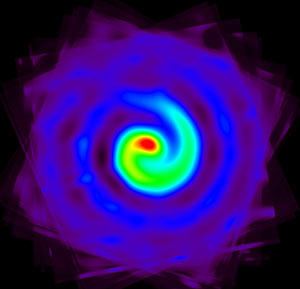Free sample! |
 Advertisement SYDNEY: A spectacular, rotating binary star system is a ticking time bomb, ready to throw out a searing beam of high-energy gamma rays – and Earth may be right in the line of fire. Astronomers at the University of Sydney, in Australia, first discovered the unusual and beguilingly beautiful star system eight years ago in the Constellation Sagittarius. One member of the pair is a highly unstable star known as a Wolf-Rayet, thought to be the final stage of stellar evolution to precede a cataclysmic supernova explosion. "When it finally explodes as a supernova, it could emit an intense beam of gamma rays coming our way", said Peter Tuthill, lead researcher of the team who report their findings in the current Astrophysical Journal. Vast and glowing plume At a distance of 8,000 light years from Earth, the pair of stars are a short hop away in galactic terms, and just one quarter of the way to the centre of our Milky Way galaxy. The researchers took images of the system, known as WR 104, over a period of eight years using Hawaii's Keck Telescope. These images reveal a vast and glowing plume of heated dust and gas, billowing out in a spiral as the stars rotate once every eight months. This 'tail' is up to 30 billion kilometres long. But something curious about the images caught the attention of the experts. "Viewed from Earth, the rotating tail appears to be laid out on the sky in an almost perfect spiral. It could only appear like that if we are looking nearly exactly down on the axis of the binary system," said Tuthill. This means we are peering down the barrel of the gun, as when binary supernovae go off, all their energy is focussed into a narrow beam of wildly destructive gamma ray radiation that emanates (both up and down) from the poles of the system. "If such a gamma-ray burst happens, we really do not want Earth to be in the way," he said. "I used to appreciate this spiral just for its beautiful form, but now I can't help a twinge of feeling that it is uncannily like looking down a rifle barrel." Sterilising effect Though the risk may be remote, there is evidence that gamma ray bursts have swept over the planet at various points in Earth's history with a devastating effect on life. A 2005 study showed that a gamma-ray burst originating within 6,500 light years of Earth could be enough to strip away the ozone layer and cause a mass extinction. Researchers led by Adrian Melott at the University of Kansas in Lawrence, U.S., suggest that such an event may have been responsible for a mass extinction 443 million years ago, in the late Ordovician period, which wiped out 60 per cent of life and cooled the planet. Further research would be required to determine if we are exactly in line with the axis of the system – but even if we are, we probably still have hundreds of thousands of years to come up with a solution, said Tuthill. with the University of Sydney
|
COSMOS newsletter!Receive regular updates highlighting the latest in science from COSMOS. Latest News |
||




